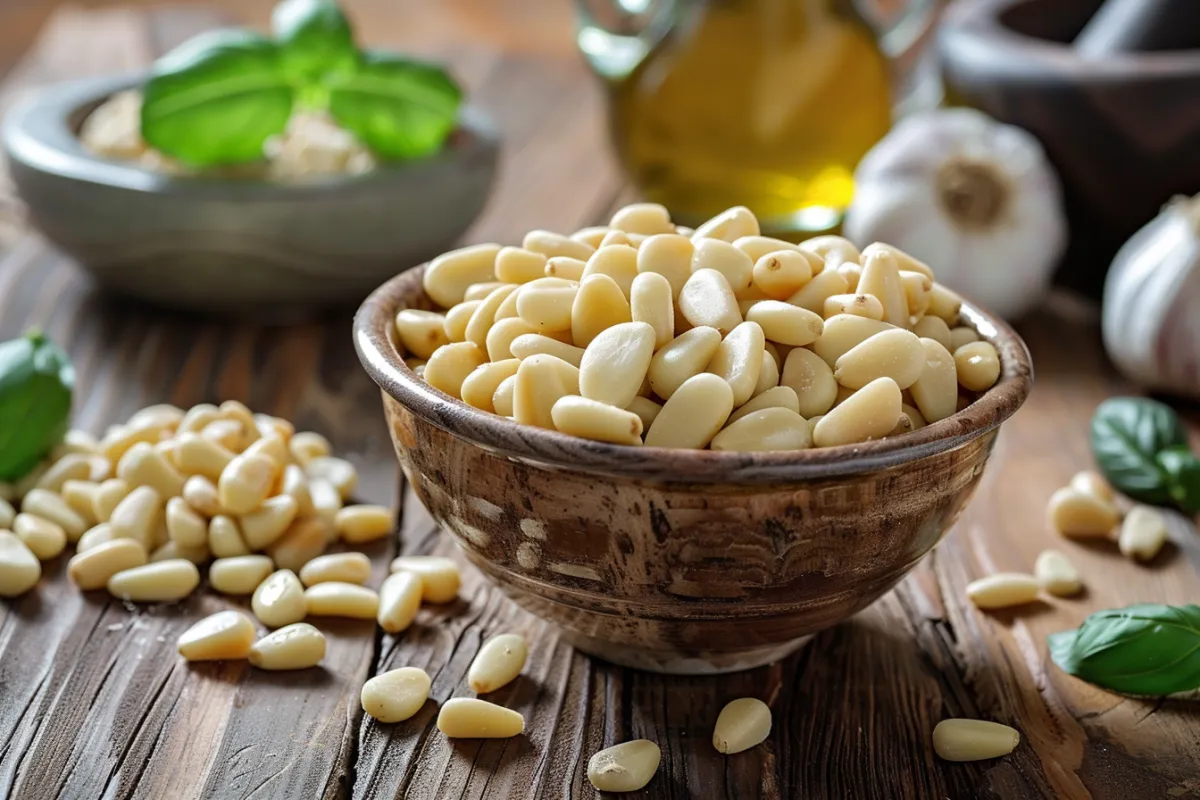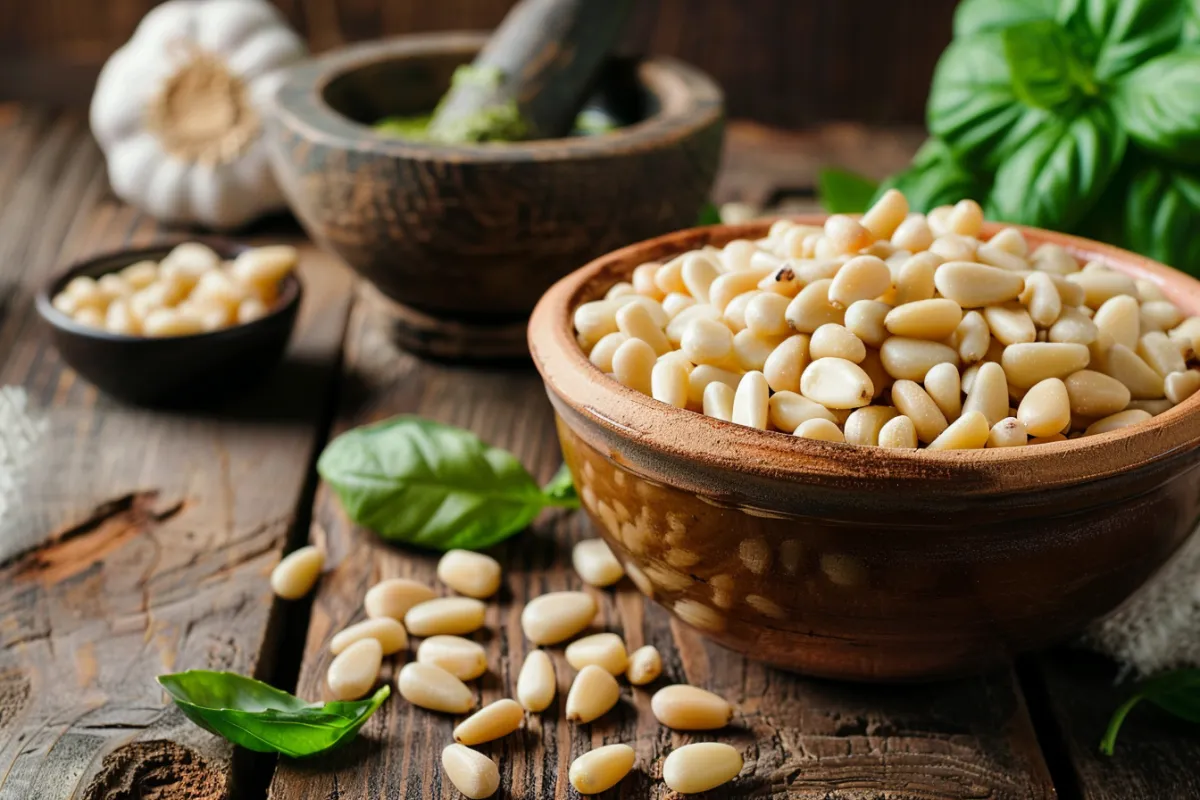If you love Italian cooking or enjoy a good pesto, you’ve probably come across pine nuts or pignoli in recipes. However, the question often arises: Are pine nuts and pignoli the same? These small, buttery seeds are essential in Mediterranean cuisine, but the names can cause confusion. In this article, we’ll explore whether pine nuts and pignoli are indeed the same, examine their culinary uses, and explain why they hold such a special place in kitchens around the world. By the end, you’ll know everything about this delightful ingredient and how to make the most of it.
What Are Pine Nuts?
Pine nuts are the edible seeds harvested from certain species of pine trees. These small, ivory-colored seeds come from within hard shells that must be removed before eating. The process of gathering and shelling pine nuts requires significant effort, which contributes to their high price. Their mild, buttery flavor and tender texture make them a sought-after ingredient in numerous dishes.
Used across various cuisines worldwide, pine nuts can be incorporated into both savory and sweet recipes. They are a staple in Mediterranean cooking, especially in dishes like pesto, salads, and baked goods. Their subtle, nutty flavor enriches any meal.
Origins of Pine Nuts
Pine nuts have been enjoyed for thousands of years. Ancient civilizations in Europe, Asia, and North America harvested these seeds as a valuable food source. Today, the majority of pine nuts come from regions such as the Mediterranean, Asia, and parts of North America.
Countries like Italy, Spain, and China are major producers of pine nuts. The pine trees they harvest from, such as the Pinus pinea, or Italian stone pine, provide the type of pine nuts most commonly used in Mediterranean dishes. The flavor of pine nuts varies slightly depending on their geographical origin and the species of pine tree from which they are harvested.
What Is Pignoli?
While pine nuts may be more familiar in English-speaking countries, pignoli is the Italian word for these seeds, especially when used in traditional dishes. Pignoli refers specifically to pine nuts in the context of Italian cuisine, where they play an essential role in recipes such as pesto and pignoli cookies.
The term pignoli derives from the Italian word for pine cone, pigna, which is where the seeds are harvested. While the word pignoli is often used in Italian culinary contexts, it is simply another term for pine nuts.
The Difference in Terminology: Pine Nuts vs. Pignoli
The distinction between pine nuts and pignoli is primarily linguistic and cultural. In English, we typically refer to them as pine nuts, but in Italy, they are called pignoli. The names may differ, but the ingredient is the same. This dual naming can cause confusion, but understanding that pignoli refers to the Italian usage of pine nuts helps clarify things. Whether you’re making pesto or a dessert, pignoli and pine nuts are interchangeable.
Are Pine Nuts and Pignoli the Same?
So, are pine nuts and pignoli the same? The answer is yes. Despite the different terms, both refer to the edible seeds from pine trees. However, the context in which they are used can vary slightly. In the United States, we commonly refer to them as pine nuts, while in Italy, the word pignoli is used, particularly when referring to culinary applications.

Although the terms may differ, the product is the same. Whether you’re cooking an Italian dish or experimenting with Mediterranean flavors, pine nuts and pignoli offer the same rich, nutty taste.
Why the Confusion?
The confusion around whether pine nuts and pignoli are the same stems from regional naming conventions. Here’s a quick breakdown of how they’re referred to in various regions:
- In Italy, the seeds are called pignoli, and they are a key ingredient in dishes such as pesto and desserts like pignoli cookies.
- In English-speaking countries, they are known as pine nuts.
- In Spain, the seeds are referred to as piñones, used in traditional Mediterranean recipes.
By understanding these regional variations, you can confidently use either term in the kitchen, knowing they refer to the same ingredient.
Varieties of Pine Nuts
Though all pine nuts come from pine trees, different species produce slightly different varieties. Each variety of pine nuts offers unique flavors, textures, and uses.
1. Pinus Pinea (Italian Stone Pine)
The most well-known variety of pine nuts comes from the Italian stone pine. These pine nuts are commonly used in Mediterranean cuisine due to their mild, sweet flavor and tender texture. They are often used to make pesto and other Italian dishes.
2. Pinus Koraiensis (Korean Pine)
Korean pine nuts are larger and have a stronger flavor compared to their Mediterranean counterparts. They are widely used in Asian cuisine, particularly in Korea and China, where they add a distinctive nuttiness to dishes.
3. Pinus Cembra (Swiss Stone Pine)
The Swiss stone pine produces smaller pine nuts, which have a slightly more intense flavor. These nuts are often harvested in the Alps and are popular in European dishes, especially in Switzerland.
4. Pinus Gerardiana (Chilgoza Pine)
Chilgoza pine nuts are harvested in the Himalayan region and are commonly used in Indian and Middle Eastern cooking. Their unique, fruity flavor makes them stand out from other varieties.
Taste and Texture Differences
The taste and texture of pine nuts depend on their variety and region of origin. Mediterranean pine nuts, such as those from the Italian stone pine, are known for their mild sweetness and creamy texture. In contrast, pine nuts from regions like Asia have a bolder, more distinct flavor. Roasting pine nuts enhances their natural flavor, adding a crunchy texture and a rich, nutty taste.
Culinary Uses of Pine Nuts and Pignoli
Both pine nuts and pignoli are versatile ingredients used in various global cuisines. Their soft texture and subtle flavor make them suitable for both sweet and savory dishes.
Italian Cuisine
In Italian cooking, pignoli are a key ingredient in many beloved dishes. Here are some examples:
- Pesto: Pignoli are blended with basil, garlic, Parmesan cheese, and olive oil to create the classic pesto alla Genovese.
- Pignoli Cookies: These traditional Italian cookies, made with almond paste and rolled in pignoli, are popular during holidays and special occasions.
Mediterranean Dishes
Throughout the Mediterranean, pine nuts are used to add texture and flavor to salads, grain-based dishes, and vegetable recipes. They provide a nutty richness that complements the fresh, bright flavors often found in Mediterranean cuisine.
Global Cuisines
- In the U.S., pine nuts are commonly used in salads, roasted vegetable dishes, and even baked goods.
- In the Middle East, they are often added to rice dishes, stuffed vegetables, and used as a garnish for lamb and chicken dishes.
- In Asia, especially in Korean and Chinese cuisine, pine nuts are used to add crunch and flavor to stir-fries, sauces, and desserts.
Roasting Pine Nuts for Enhanced Flavor
Roasting pine nuts intensifies their flavor and gives them a delightful crunch. Roasted pine nuts are excellent in salads, over pasta, or as a snack. To roast pine nuts, follow these simple steps:
- Preheat the oven to 350°F (175°C).
- Spread the pine nuts in a single layer on a baking sheet.
- Roast for 5-10 minutes, shaking the pan occasionally to ensure even browning.
- Keep a close eye on them, as pine nuts can burn quickly.
Health Benefits of Pine Nuts and Pignoli
Beyond their rich flavor, pine nuts and pignoli offer numerous health benefits. These small seeds are packed with essential nutrients that contribute to a balanced diet.
Rich in Nutrients
- Vitamins: Pine nuts are a good source of Vitamin E, which supports skin health, and B1, which aids in energy production.
- Healthy Fats: They are high in monounsaturated fats, which can help lower bad cholesterol levels and support heart health.
- Minerals: Pine nuts contain important minerals like magnesium, zinc, and iron.
Benefits for Heart Health
The healthy fats in pine nuts are known to reduce bad cholesterol (LDL) while increasing good cholesterol (HDL). This can lower the risk of heart disease when consumed as part of a balanced diet.
Antioxidant Properties
Pine nuts are rich in antioxidants, which help protect the body from damage caused by free radicals. These antioxidants play a role in reducing inflammation and slowing the aging process.
How to Store Pine Nuts and Pignoli
Because pine nuts contain a high amount of healthy fats, they can spoil if not stored properly. To keep them fresh for longer, follow these storage tips:
- Use an airtight container: Store pine nuts in an airtight container to protect them from air and moisture.
- Refrigerate or freeze: Keep pine nuts in the refrigerator or freezer to extend their shelf life. They can last up to six months in the fridge or even longer in the freezer.
Proper storage will help prevent your pine nuts from turning rancid and preserve their delicate flavor.
Environmental and Economic Impact of Pine Nuts
The labor-intensive process of harvesting pine nuts contributes to their relatively high cost. Pine trees produce cones that contain a small number of seeds, and it can take years for a tree to begin producing these cones. This slow-growing cycle, combined with the manual labor required to extract the seeds, explains why pine nuts are more expensive than other nuts and seeds.
Additionally, the growing demand for pine nuts, especially in Mediterranean and Asian markets, affects their pricing. As consumers around the world continue to appreciate the unique flavor of pine nuts, their value remains high.
Frequently Asked Questions (FAQs)
What is another name for pine nuts?
Another name for pine nuts is pignoli in Italian. In Spanish, they are called piñones. The name can vary depending on the region, but all refer to the same edible seeds harvested from pine cones.
Are pine nuts ok for nut allergy sufferers?
While pine nuts come from pine trees and are technically seeds, they may still cause allergic reactions in people with tree nut allergies. It’s essential to consult with a doctor before consuming pine nuts if you have a nut allergy.
Are raw pignolias pine nuts?
Yes, raw pignolias are simply raw pine nuts. The term pignolias is another way of referring to pine nuts, particularly in Italian cuisine.
What are pine nuts called in Mexico?
In Mexico, pine nuts are called piñones. They are commonly used in Mexican cuisine, especially in desserts and savory dishes like moles and stuffed chiles.
Conclusion
So, are pine nuts and pignoli the same? Absolutely. The difference lies only in the name, with pignoli being the Italian term for pine nuts. Whether you’re making pesto, pignoli cookies, or adding them to a salad, these small seeds bring a unique, buttery flavor to any dish. By understanding their varieties, health benefits, and proper storage methods, you can appreciate the versatility of pine nuts in your kitchen. So, the next time you come across a recipe calling for pignoli, you’ll know exactly what to do!

